on all orders over $100
on all orders over $100
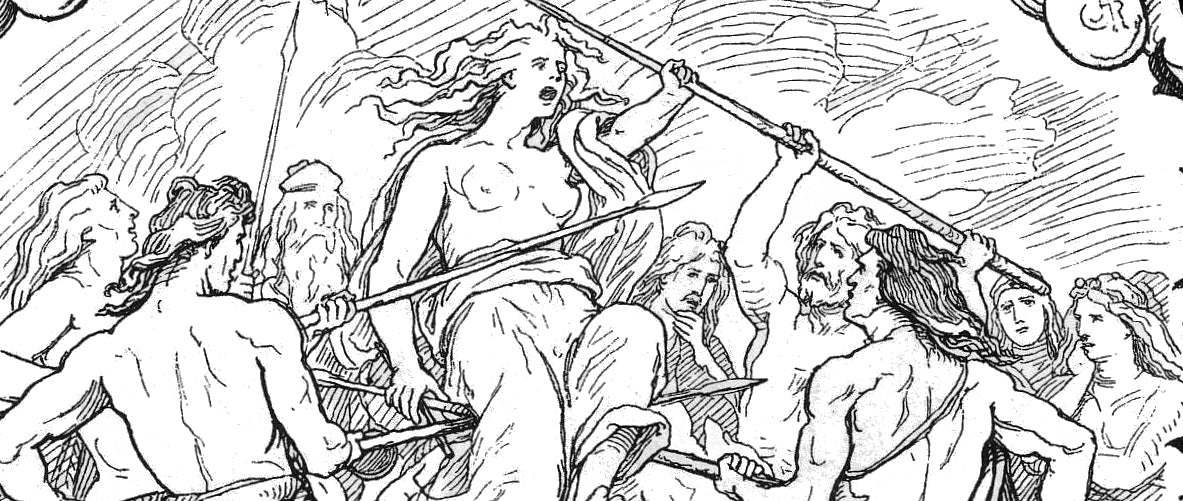
In Norse Mythology Freya (Spelt Freyja in Old Norse) was originally a Vanir Goddess, however she spent most of her time living with the Aesir because she was sent there as one of the hostages to ensure the peace after the war between the two tribes. Eventually she became an honorary member of the Aesir tribe and was accepted by them once the hostilities had ended.
The name Freyja means 'Lady' in Old Norse, She was the son of Njord and twin sister of Freyr, who were other prominent members of the Vanir. Freyja is considered the goddess of both Love and War, often associated with fertility, sex, lust, war and death.
It was said that Freyja was one of the most beautiful of all the goddesses, when she cried her tears would turn into gold. She is described as having a love for fine jewelry, poetry and music, often spending hours listening to them. As a beautiful goddess she had many admirers, Gods, Drawves and Giants all marvelled at her beauty.

Freyja in the Dwarf's Cave (1891) by Louis Huard
As the highest ranking Goddess amongst the Aesir tribe Frigg was Odin's wife and mother of Baldur. Unusually for such a prominent member of the Aesir there is not much information about Frigg and her character. Most of the times when she was mentioned in the sagas was together with Freyja, it is thought that since the two of them supposedly originated from the early germanic goddess Frija, that they might be distinct from each other in name only.
Frigg was depicted as a practitioner of a mysterious type of Norse magic called Seidr. It allowed her to see into the future and within its scope bring about changes to shape the course of fate. In one story Loki insults Frigg and is warned by Freya that her powers allow her to see and change the fate of all beings.
As the wife of Odin Frigg was often alone in Asgard while her husband was away travelling, as he did so very frequently. There were numerous mentions of her having extra marital affairs with slaves and even with Odin's own brothers Villi and Ve.
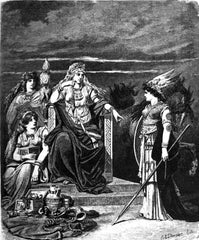
Frigg sits on her throne - Carl Emil Doepler, 1882
Gefion, also known as 'Gefjun' or 'Gefiun' was a Norse goddess of fertility, plentitude and agriculture. The name 'Gefion' comes from the Old Norse word 'gefa' which translates into modern English as the verb 'to give'.
The majority of the information of about Gefion comes from the Prose Edda by Snorri Sturluson. It says that she first travelled as a homeless woman on her way to what is now known as Sweden. She went before the king Gylfi, who told her that he would give her all of the land that she could plow by four oxen in one single day. She then summoned her four sons, who were half giant, and transformed them into oxen. They were so strong that they actually dragged the land all the way from Sweden and into the sea, where it became the Danish island of Zealand, where Copenhagen is now situated.
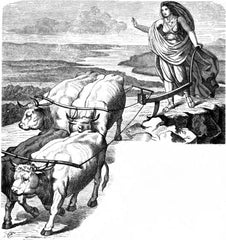
Gefjun Plows Zealand with her Oxen (1882) by Karl Ehrenberg
Being the wife of Thor, one of the most prominent members of the Aesir, Sif was often referenced in Norse sagas. Although frequent her mentions are often brief, so not a huge amount is actually known about this Goddess.
She was said to be the mother of Ullr, however it is also known that Thor wasn't his father which sheds light on her character and implies she had the same promiscuous tendencies as the aforementioned Frigg.
Sif also appears in the story about the creation of Thor's hammer, Mjolnir. In this saga she has her beautiful long, blonde hair cut by Loki. Thor was so enraged by this that he threatened to murder Loki, only dissuaded when the trickster offered to find her a replacement head of hair.
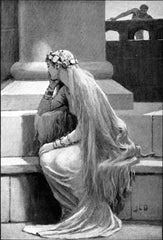
Sif - John Charles Dollman, 1909
Sigyn was another Aesir goddess and was the wife of the infamous trickster, Loki. Together they had one son, named Nafri, although Loki fathered other children outside of their marriage.
The name 'Sigyn' is thought to come from the Old Norse words 'sigr' and 'vina' which mean 'victory' and 'friend' respectively, therefore giving us a modern English translation of something like 'friend of victory'.
In the saga that tell of the death of Baldur as part of their punishment for Loki they turn his son Vali into a giant wolf who then rips out Nafri's entrails. They immediately harden and turn into an iron chain which the other gods use to bind Loki. As the final part of the punishment they drop poison onto his head from a snake that is held above him.
In this saga Sigyn shows her character as a true a loyal wife as she sits with Loki and holds a bowl above his head to catch the poison. Although she stayed as long as she could she had to leave to empty the bowl on occasion and the drops would hit Loki in the head, causing him to squirm in agony and cause earthquakes around Midgard.
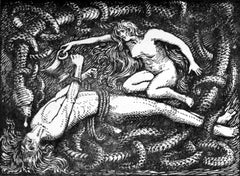
Loki Bound - W. G. Collingwood, 1908
In Norse Mythology Idun was the goddess of spring and youth. She was the daughter of a dwarf named Ivald and was married to Bragi, who was the god of poetry and music. She was said to possess the apples of youth, which kept her eternally young and beautiful, other gods and goddesses also came to her to help them become immortal.
One of the main references to Idun in the Norse sagas comes from 'the kidnapping of Idun'. In this saga Loki was forced to make a deal with the giant Thjazi, who had disguised himself In the form of an Eagle, to capture Idun and her apples and bring them to Jotunheim. Loki begrudgingly agrees and tricked her into following him there by telling her that there were more powerful magical fruits there and she should bring her own for comparison. In her absence the Aesir gods could feel their youth drawing away as they became wrinkled and feeble.
Upon discovering that she was last seen with Loki they threaten him that if he doesn't bring her back they will kill him. Freya then gave her hawk feathers to Loki, which allowed him to transform into a hawk and he flew to Jotunheim to rescue Idun. Fortunately for him the giant had gone fishing leaving his captive alone, seizing the opportunity Loki grabbed her and flew away. When he returned the giant was enraged and transformed into an eagle once again to give chase.
As they were nearing Asgard the giant was fast approaching Loki, when the other gods say this they built a huge wall of kindling around the fortress which they lit as soon as Loki was inside. Unable to slow down in time the giant flew straight into the hot flames and met his end.
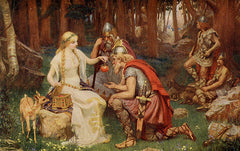
Idun and the Apples - James Doyle Penrose, 1890
Nerthus was a Norse goddess who was thought to be one of the Vanir deities. The first account of her was written by a roman historian before the start of the Viking Age in the 1st century AD when she was mentioned in his account of Germania. This writing is thought by modern scholars to indicate that she was on the island of Zaeland in Denmark.
She is theorised to be a member of the Vanir due to the account of her riding on a wagon, which was a common practice amongst the Vanir gods. There are various archaeological finds of ceremonial wagons around Scandinavia including in the Osperg Ship site. The god Freyr, also of the Vanir, was said to ride a wagon through the countryside every year with a priestess who would bless the fields and ensure a good harvest season.
There are many similarities between Nerthus and Njord, the name 'nerthus' is thought to be a latinised version of 'Njord'. Though there are many similarities between the two figures, however Njord was a male god and Nerthus was female. This leads historians to believe that either they are a divine pair such as Freya and Frigg or that the character was a hermaphroditic deity.
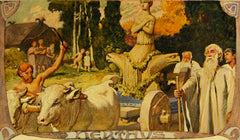
Nerthus - Emil Doepler, 1905
In the Norse sagas Jord is not mentioned often, however she plays an important role in Norse Mythology being the mother of one of the most prominent Gods of the Aesir, Thor. She was a giantess and the daughter of 'Nott' and 'Anar'.
Thor's mother was referred to numerous times during the eddic poems, however often by different names. It is widely accepted that since all of these names have a similar meaning of 'earth' that they were different names for the same deity.
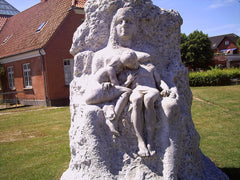
Statue of Jord - Alexander Henning Drachmann
Hel is a goddess of the underworld who is mentioned in both the Poetic Edda and the Prose Edda. She was the daughter of Loki and the giantess angrboda, said to be a glum and brooding figure, which is a stark contrast to how she was depicted in the Marvel version. Once the other gods discovered the existence of her and her two brothers, Fenrir and Jormungandr they knew that since they grew up in Jotunheim they were prophesied to cause trouble, Their fellow gods then banished the trio.
She was sent to rule over the realm of Hel, the same as her name, which was located beneath Nilfheim. This was where the dead who die not die in battle and go to Valhalla, but died from disease and old age were sent.
Hel features in the saga 'the death of Baldr' where she is approached by Hermodr and asked to return Baldr to the realm of the living. She agrees but only if every living creature in the nine realms wouldl weep for Baldr, however one Jotun giantess did not, and therefore Baldr was not permitted to ride home with his brother.

Hel (1889) by Johannes Gehrts
Gullveig was a Vanir goddess who was referenced in the Poetic Edda's description of the war between the Aesir and Vanir clans. She had powerful magic and was a practitioner of seidr, which was a type of Norse magic that allowed her to see into the future and make adjustments to fate.
This Goddess is only mentioned in the Poetic Edda where it says that she was stabbed by the Aesir with a spear and then burned three times during the war, however three times she was reborn due to her magical abilities. Some scholars suppose that her and Freyja are actually the same character, but with a different name, due to their similar abilities and stories.
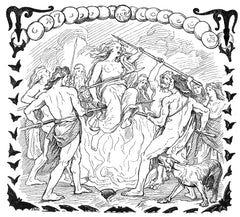
Gullveig being speared and burned - Lorenz Frølich, 1895
If you enjoyed our blog post or have anything to add please leave a comment below.
Check out some of our handmade Viking Axes.
Leave a comment